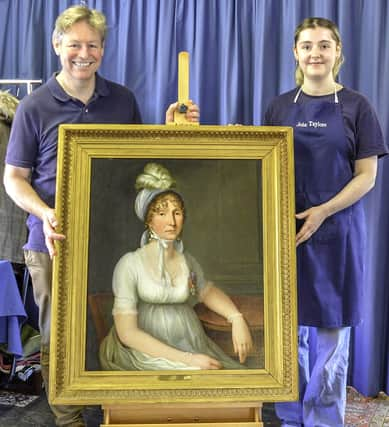Louth auctioneer's daughter identifies18th century Duchess in £1,400 painting


Auctioneer James Laverack’s daughter, Oxford Brookes University criminology graduate Georgia Laverack, was asked by her dad to find the identity of the unidentified woman posing in a portrait that has been hanging on the dining room wall in a Victorian townhouse for years.
The painting, titled on a frame plaque simply as ‘A Portrait of a Lady’, was consigned for sale to John Taylors saleroom in Louth by a downsizing vendor, who had inherited the picture 35 years ago from his father, who is thought to have bought it in London.
Advertisement
Hide AdAdvertisement
Hide AdThey never knew the name of the sitter, so James tasked Georgia, who is helping out in the saleroom for the summer, on to the case.
Georgia’s detective work found that the sitter is none other than an 18th century German Duchess of Bavaria, Maria Anna, Countess Palatine of Zweibrucken-Birkenfeld-Bischweiler, sister of Maximilian I, King of Bavaria who lived between 1753 to 1824.”
James said: “Georgia photographed the portrait and then used an Internet image search programme to see if we could gather any clues.
"That threw up literally hundreds of possibilities but she worked her way through dozens of them – and hit the jackpot.
Advertisement
Hide AdAdvertisement
Hide Ad“It came as quite a surprise when the search took us to Germany, to Neuburg an der Donau, a town about sixty miles from Munich. The Rathause (town hall) collection has an almost identical portrait that enabled us to identify.”
Georgia said: “Getting such a good match was a real stroke of luck, very unexpected. The two portraits are incredibly similar. There are little differences but they are very slight.
“Particularly useful was the fact that both paintings depict the Duchess wearing the Order of St. Elizabeth, an exclusive all-female chivalric and charitable order founded in Bavaria in 1766 by the Electress Elisabeth in memory of her namesake saint.
“The order’s purpose was to help the poor but it was an ultra-aristocratic organisation. A condition for admission was proof of noble descent running through 16 generations of the ancestors of the candidate or her husband.”
Advertisement
Hide AdAdvertisement
Hide Ad“Duchess Maria-Anna did not need the ancestry of a husband to qualify. She was admitted at the age of 13 – although it may have helped that the founder of the order, Electress Elisabeth, was her aunt.”
The painting went under the hammer in the June auction at the Old Wool Mart in Louth on Tuesday (June 27 ) and sold at £1,400, more double the top pre-sale estimate, to a buyer from Durham.
James added: “Quite how a portrait of a German Royal Duchess came to be hanging on a dining room wall in Lincolnshire 200 years after her death remains a mystery, but at least she is no longer merely an anonymous ‘lady’.”